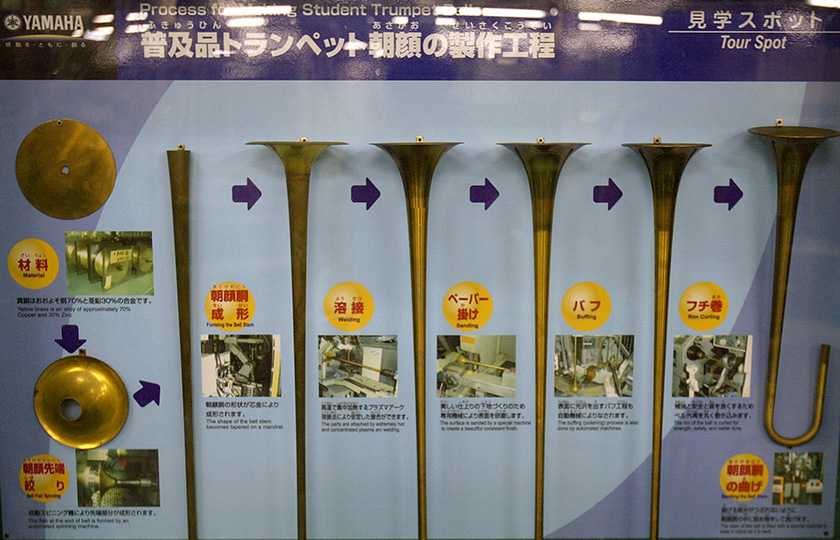Choosing a Trombone
Choosing by bell shaping method
1-piece bell or 2-piece bell?
There are two major ways of shaping the bell. The first involves shaping it from a single sheet of metal, while the second involves shaping two sheets separately and then joining them together.
1-piece bell characteristics
- The traditional method, in which the bell is shaped from a large ginkgo leaf-shaped sheet of metal
- The sheet grows thinner toward the end
- Easier for the craftsperson to put his or her unique touch on the final product

Model showing how a 1-piece bell is made

Hammering a 1-piece bell by hand
2-piece bell characteristics
- Created by joining a wide and large part with a small part
- More consistent overall (including panel thickness), so there is less chance of the final product showing any fluctuation
- Shaping the bell is comparatively easy

Model showing how a 2-piece bell is made
The shaping method affects the timbre
Even if the same material is used (for example, gold brass), 1-piece bells and 2-piece bells are shaped using different methods and so they will show some differences in how they feel to play and in their timbres.
As the name suggests, a 1-piece bell is formed from a single sheet of metal (shaped like a ginkgo leaf). The metal is folded into a round shape and welded, which leaves a "spine" running lengthwise along the bell. This causes lengthwise vibrations to be emphasized, resulting in a more pronounced reverberation.
2-piece bells are formed from two pieces (the flare piece at the end and the stem) which are welded together right around where the bell is engraved. These bells are generally easier to play and provide a brighter reverberation.
The shape (the wind) of an F attachment also affects the timbre.
Musical Instrument Guide:Trombone Contents
Structure
How to Play
How the Instrument is Made
Choosing an Instrument
Care and Maintenance
Trivia
- God is in the trombone
- The trombone was a bit of a problem for cavalries...
- A trombone that would scare even a snake!
- Two instruments, both tenor, but quite different!
- A trombone player walks into pawnshop...
- You can trill just by moving your mouth
- It is possible to increase the pitch even as you extend the slide
- Famous pieces from trombone concertos
- Orchestra pieces in which the trombone plays an important role
- The Yamaha quartet
- For trombones, why does sheet music notation differ from the fundamental tone of the instrument?
- A bass trombone-with an F attachment only
